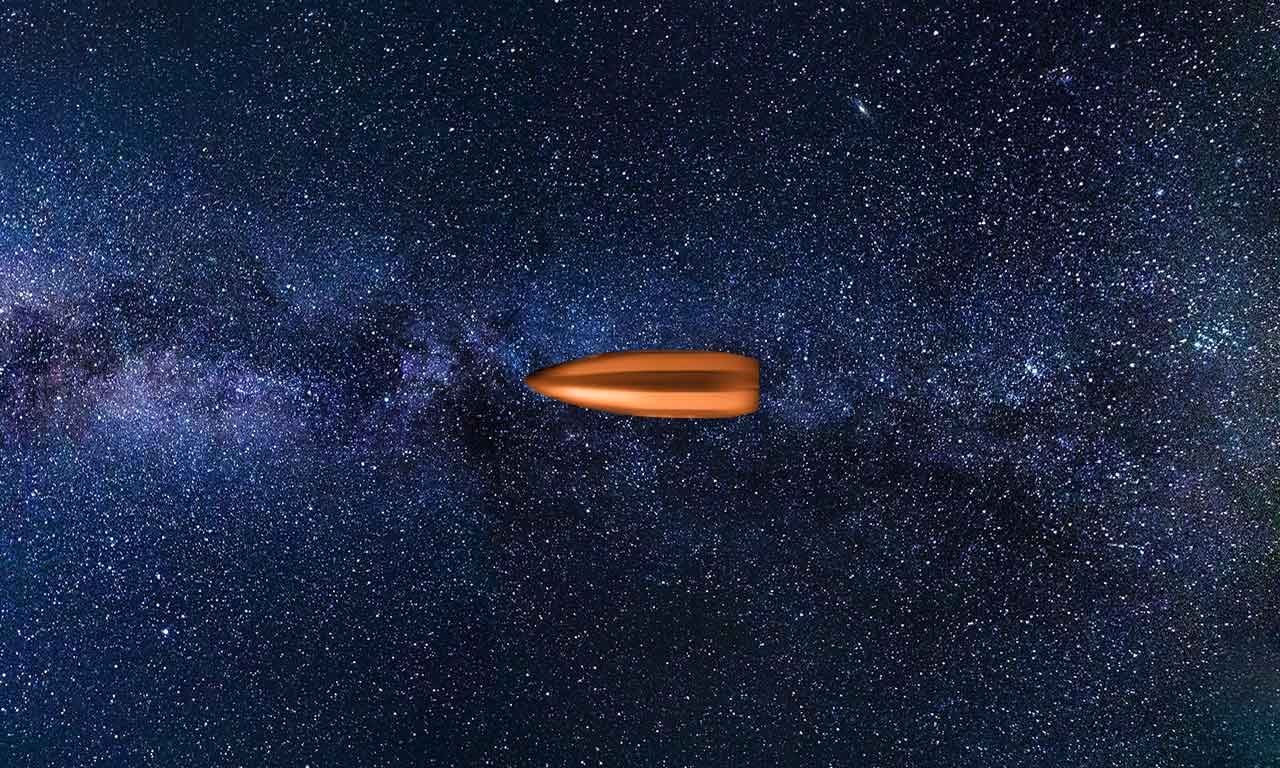Theoretically, one can imagine that if a bullet is shot in space, it will travel at a constant velocity in the direction it was fired, indefinitely. However, there are other factors to take into consideration. Space is not a complete vacuum. There is material in space although not as much as we see here on Earth.
Gravity Drag
Space has celestial bodies like asteroids, moons, planets, stars, black holes, galaxies, etc. Everything that has a mass also has gravity. The higher the mass the higher the gravity. In fact, the amount of gravity of an object is proportional to its mass and distance between it and another object (in our case, it’s the bullet).
According to Newton’s law of universal gravitation, the force (F) of gravitational attraction is directly proportional to the product of two masses (\(m_1\) and \(m_2\)), and inversely proportional to the square of the distance (\(r^2\)) between the centres of two masses. Thus the equation for universal gravitation can be written as follows:
\(F = \frac{G(m_1*m_2)}{r^2}\)where G is the gravitational constant, which has the same value throughout our universe.
The speed of the travelling bullet will be influenced by the gravities of celestial bodies. But as the bullet distances itself from these celestial bodies, the gravitational pull gets weaker.
Particle Drag
Bullet in Interplanetary Space
Interplanetary space is the space between planets. The materials that fill up the interplanetary space are called the interplanetary medium (IPM). The interplanetary medium includes dust particles, cosmic rays and hot plasma from the solar wind.
The density of the interplanetary medium is very low. There are about 5 particles for every cubic centimetre in the vicinity of the Earth. During events such as coronal mass ejections, the particle count may rise to as high as 100 particles per cubic centimetre.
If the bullet is travelling in the interplanetary space, the interplanetary medium will slow it down a bit. But as the distance from the Sun increases, the number of particles per cubic centimetre decreases. So it’s better for the bullet to travel away from the Sun.
Bullet in Interstellar Space
Interstellar space is the space between star systems in a galaxy. The interstellar medium (ISM) includes gas in ionic, atomic and molecular form, as well as dust and cosmic rays.
The low-density gas occupies 99% of the interstellar space. The rest 1% comprises of dust particles. Compared to the interplanetary medium (IPM), the interstellar medium (ISM) is extremely tenuous by terrestrial standards. This gas is extremely dilute, with an average density of about 1 atom per cubic centimetre.
Voyager 1 entered the interstellar medium on August 25, 2012, making it the first man-made object from Earth to do so. Voyager 2 entered the interstellar medium in November 2019. Both space probes are helping us study the interstellar medium.
So if the bullet is travelling in the interstellar space, the drag would be minimal. The bullet will probably continue to fly for a very long time until all its energy gets absorbed.
Bullet in Intergalactic Space
Intergalactic space is the space between galaxies. Intergalactic space is out of our reach until we develop faster propulsion systems. The intergalactic medium (IGM) comprises of a rarefied plasma that is organized in a galactic filamentary structure. It consists mostly of ionized hydrogen; i.e. a plasma consisting of equal numbers of electrons and protons.
Our universe is expanding at a speed of 72 kilometres per second per megaparsec. So the matter that is 1 megaparsec away from the bullet is travelling faster than the speed of the bullet itself. With the ever-expanding universe, the bullet will quite literally travel forever into the void.
